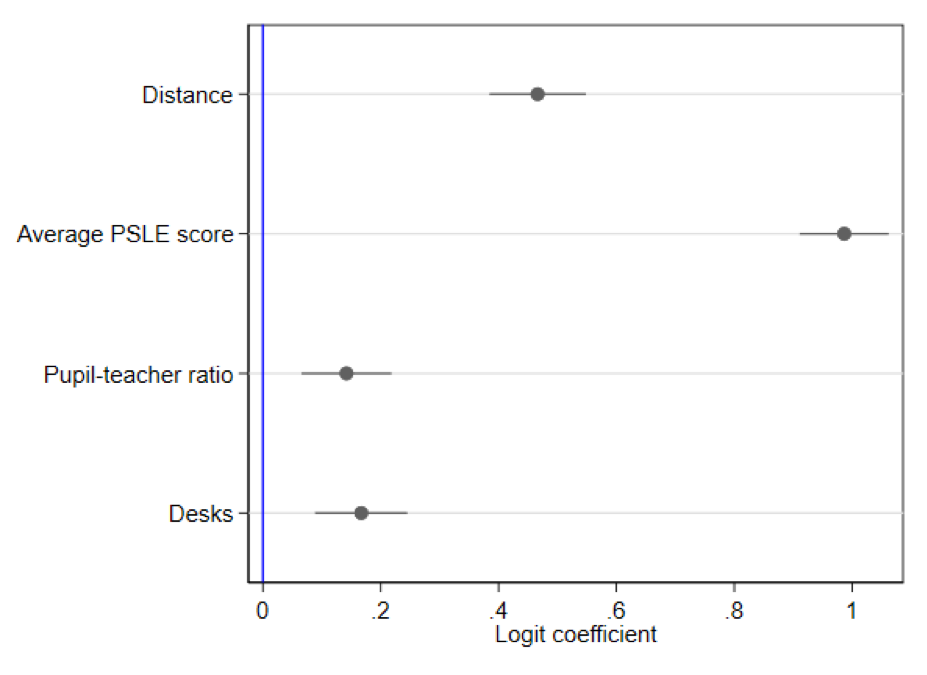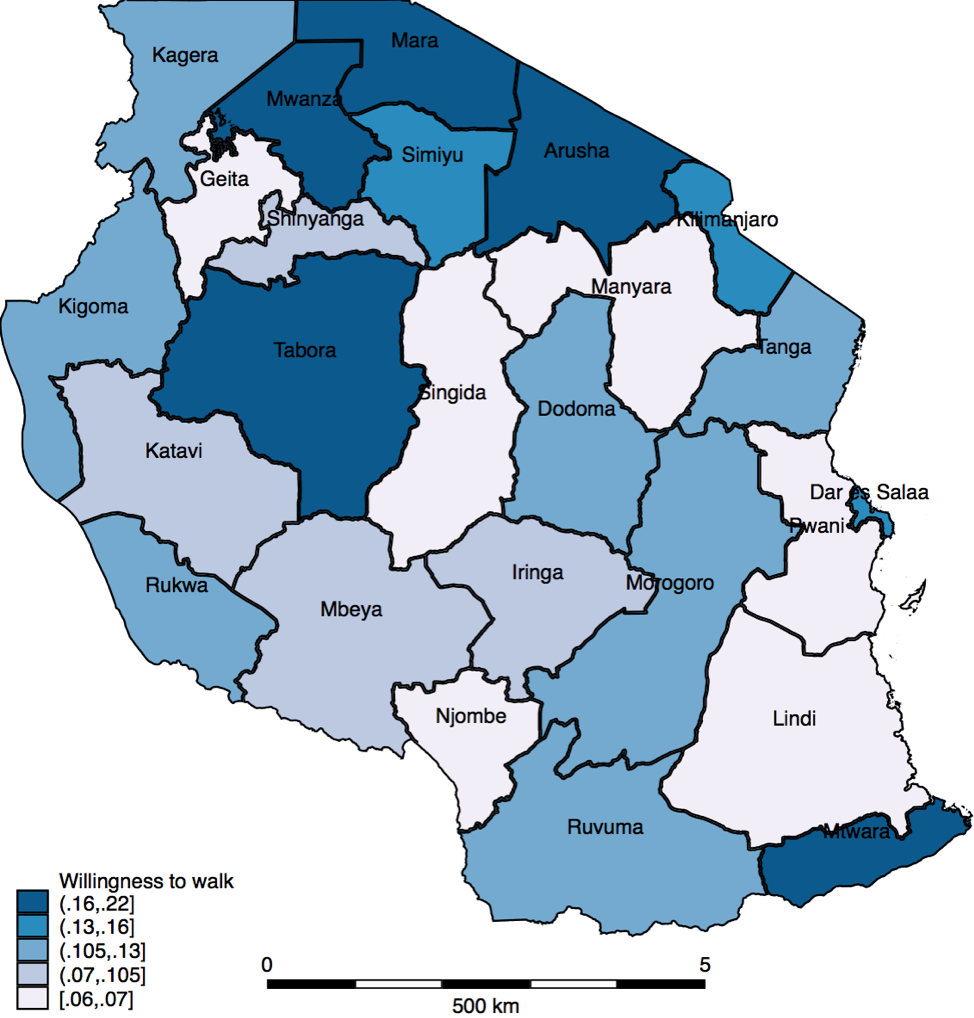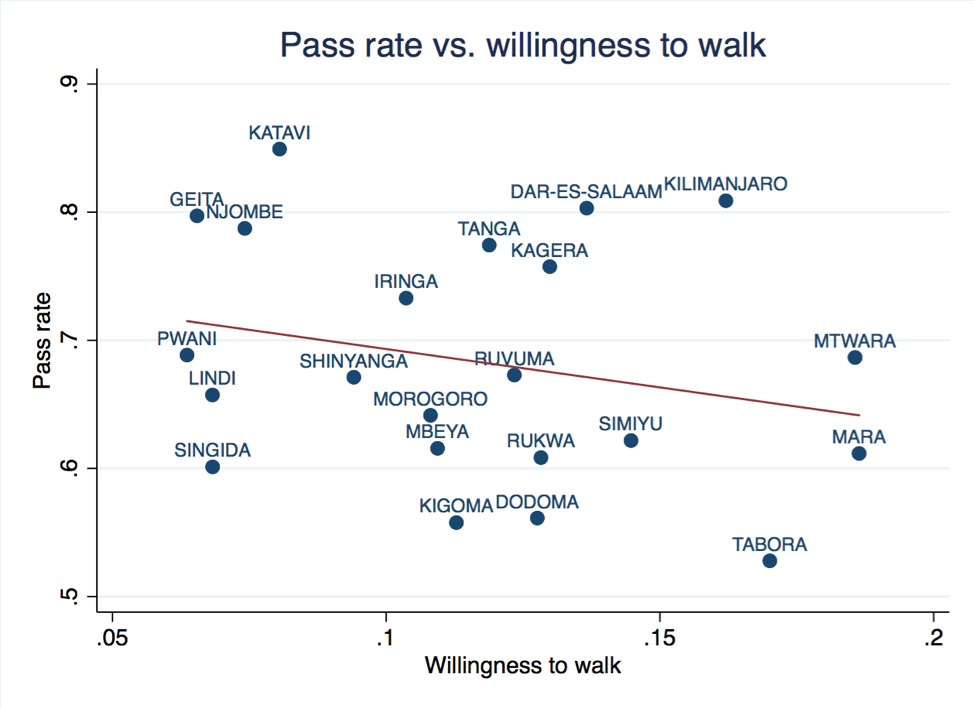Samuel Solomon
Yale University
Insight Note
- Parents’ choices are driven by proximity and learning quality, with little additional role for class sizes or infrastructure quality.
- Parents’ willingness to walk for learning outcomes— their tradeoff between distance and quality—varies widely by region.
- Regional variation in willingness to walk for learning is not reflected in the mix of services provided by the school system.
Parents want their children’s school to be many things. They want it to be clean. They want it to be safe. They want it to be close. They want it to foster learning. And the strength of these preferences is reflected in their choices not only over where to send their children, but also how to support and hold accountable that school, and the political and educational system that delivered it.
Consequently, understanding what Tanzanian parents value in the primary schools to which they send their children can help the Government of Tanzania to better serve its citizens. These preferences will shape the accountability pressures that parents may exert on the system. They also serve an important instrumental role in the creation of learning: education systems that deliver high parental satisfaction may be more likely to see sustained parental engagement, manifesting in low rates of student absence and drop-out. In spite of this, education systems rarely collect systematic evidence on parental values and satisfaction levels.
In this brief, we summarise recent RISE research, conducted as part of Twaweza’s Sauti za Wananchi survey, that seeks to address precisely this gap.1 We use a ‘discrete choice’ experiment—a series of hypothetical enrollment decisions in which parents were asked to express their preferences between alternative pairs of schools—to understand the extent to which parents value proximity, infrastructure, teacher-pupil ratios, and learning outcomes, in the primary schools to which they have access.
We highlight three findings:
These results complement accompanying findings from the Sauti za Wananchi survey that households choosing secondary schools prioritise high Certificate of Secondary Education Examination (CSEE) pass rates, motivated teachers, and good textbooks (Twaweza East Africa, 2018).
Our findings should be understood alongside a growing literature that seeks to understand the drivers of parental actions in school choice and accountability mechanisms (Ajayi, 2013; Andrabi, Das and Khwaja, 2017; Kapor, Neilson and Zimmerman, 2018; Lucas and Mbiti, 2012). Parents putting high value on learning outcomes is a necessary condition for making markets work toward this end, and the Sauti results suggest that this condition is met. As we discuss below, effectively harnessing parental preferences further depends on building a sufficiently thick supply of schools, with good information provided about both quality and—in the case of non-market allocation mechanisms—about the likelihood of student acceptance at different schools. These conditions are hard to meet. On the other hand, Tanzanian voters have shown a willingness to exercise dissatisfaction with the services they receive at the ballot box (Habyarimana, Opalo and Schipper, 2018). The Government of Tanzania might be wise to listen to the preferences of its citizens in planning for education services.
We use data on 1,209 respondents from the twenty-third Sauti za Wananchi survey round of their second panel of respondents. Respondents answering the questions that we focus on are all parents of a primary-school-age child. The RISE Tanzania Country Research team, in partnership with Twaweza, conducted this survey round in September and October 2017.2
Parents were asked two school choice questions. In each question, respondents were asked which of two hypothetical primary schools they would choose for their child. Each school was characterised by four features: distance from the respondent’s home, learning outcomes, pupil-teacher ratio, and availability of desks (a measure of infrastructure quality). Hypothetical schools’ characteristics were then randomly chosen from the following options:
Each of the above represents a meaningful and feasible variation in the relevant dimension of school quality. For instance, PSLE scores represent central values of the ‘red’, ‘yellow’, and ‘green’ bands of school achievement defined under the Big Results Now reforms.
Each Sauti za Wananchi respondent with primary-aged children was presented with decision tasks comprising a pair of hypothetical schools with attributes drawn at random from the above distributions. For example, in one choice task a respondent might be asked to choose between a school that is 4 kilometers away, with 30 pupils per teacher and shared desks, and an average PSLE score of 140, as compared with a school that is 1 kilometer away, with 60 pupils per teacher and some classrooms that do not have desks, and an average PSLE score of 80. Respondents made two such choices, and information from across these parental decisions is aggregated to estimate representative preferences.
We analyse these results using a logistic choice model, commonly used to analyse such discrete choice data. To facilitate interpretation, we report results as respondents’ willingness to walk for a given attribute: this highlights the rate at which households would sacrifice proximity for an improvement in a given school attribute (quality, infrastructure, teachers). Since proximity is universally valued3, this provides a natural way to characterise the strength of parental preferences.
Results of a logistic choice model that pools 2,413 pairwise choices made by 1,209 respondents are illustrated in Figure 1. In this model, each school feature is scaled so that a one-unit change corresponds to an increase in one level of that associated feature. The results imply, for example, that decreasing a school’s distance by 1 km increases its probability of being chosen by 4.5 percentage points, while increasing its average PSLE score by 10 points increases its probability of being chosen by 5.2 percentage points. Human and physical resources have smaller effects: a 10 pupil reduction in the pupil-teacher ratio increases its probability of being chosen by only 1.2 percentage points, and ensuring desks for all pupils increases the probability of being chosen by 4.4 percentage points.

We find that the average exam score and proximity are significantly more important in household decision-making than is the pupil to teacher ratio and desk availability. The relative dominance of these two features in households’ decisions suggests that to the extent that their real-world enrollment decisions are associated with pupil-teacher ratios and observable infrastructure such as desks, parents may be using these as proxies for quality, in the absence of easily accessible and salient information on learning quality to inform their choices. Because by its nature a survey experiment such as this cannot fully specify all the attributes of a school, we cannot say what aspects of the school parents assume to covary with, say, desks as a measure of infrastructure. But when the discrete choice experiment makes learning outcomes salient, households place little remaining weight on physical and even human resources in the school. This suggests that households’ valuations of these attributes are largely instrumental—as signals of learning—rather than intrinsic.
On average, parents are willing to send their children an extra 1.16 km for a school that scores 10 points more on average on the PSLE. These are significant findings given average PSLE scores of 120, and given typical travel distances of around 5 km. While putting a price tag on learning gains is hard, this is a relatively modest increase in learning that parents would be willing to trade off against an access gain that would require a large-scale investment in school construction. The findings suggest scope for investments in the intensive margin of school quality—the performance of existing schools—over the extensive expansion of the stock of schools, in order to promote grade completion and learning; these are tradeoffs that policymakers must weigh in the application of a finite budget to these goals.
This tradeoff varies geographically across Tanzania, demonstrated by Figure 2. There, darker shaded regions represent those where parents’ decisions reflect higher willingness to walk for learning outcomes; we reject pooling of preferences across regions at the one percent level. Households in Mara, for example, reveal a willingness to walk 1.86 km for an improvement of 10 points in average exam score. At the other end of the spectrum, respondents in Pwani reveal they are only willing to walk 0.64 km for the same improvement. Parents’ relative weight on learning outcomes versus school construction varies by nearly a factor of three across regions.

Willingness to walk also varies among other geographic and demographic characteristics. For example, urban households are willing to travel 1.41 km for a 10 point improvement, while rural households are only willing to travel 1.08 km for the same improvement. Households with fewer children are willing to travel farther than households with more children: households with one child are willing to travel 1.69 km, households with two children are willing to travel 1.51 km, and the pattern continues. Finally, this varies by gender as households with more male students are willing to travel 1.32 km for a 10 point improvement while households with more female students are only willing to travel 1.13 km. These patterns are suggestive of the likely beneficiaries of school construction efforts.
Given regional variation in parents’ willingness to trade off proximity for learning outcomes, are regions organized to deliver higher PSLE pass rates where this ‘willingness to walk’ for learning is high? The answer seems to be that this alignment is limited. In Figure 3, we show that there is no evidence of a positive relationship between willingness to walk for learning quality and PSLE pass rates; similar results obtain for other measures of learning quality. This suggests an unmet demand for school quality in regions such as Tabora, Mara, and Mtwara.

Several caveats should be noted here. The pass rate is an outcome not only of policies in the education sector, but also of demographic and socio-economic phenomena, and so this negative association need not reflect spending priorities. Moreover, the analysis of a discrete choice experiment such as this assumes that preferences do not depend on the supply of alternatives not directly considered in the choice presented to parents, but if parents’ observed choices are affected by the quality of schools to which they have access in reality, this might produce the appearance of lesser willingness to walk for quality in areas where actual quality is high.
Parental preferences shape their direct interactions with schools in several ways that can promote growth in learning outcomes. Where preferences for learning outcomes are strong, parents may be able to act directly to hold schools to account, or to provide complementary inputs that improve learning. And where alternatives exist—whether provided by public or private-sector schools—parents may be able to shift their children to higher-quality schools, and in so doing exert pressure on underperforming schools to improve.
However, a growing empirical literature suggests three significant barriers to these ‘short route’ forms of accountability:
Where these conditions are not met, there remains hope for the ‘long route’ of accountability to tap into parental preferences. Governments may want to design policy around these preferences, in part, for instrumental reasons. Parental satisfaction with schools’ attributes may be seen as a predictor of sustained enrollment. To the extent that governments would like to see high continuation and completion rates in their schools, keeping parents happy is key.
Political success may also depend on listening to these preferences. Ongoing RISE Tanzania research suggests that voters expressed unhappiness at the ballot box in 2010, following a school construction boom (Habyarimana et al., 2018). The suggestion is that the combination of the fiscal burden imposed locally and the quality of education that resulted may have left voters dissatisfied. Our results suggest an unmet demand for quality may underly this response at the ballot box: investments in quality, for a given set of schools, may be a more cost effective way of satisfying voter preferences.
Thus, the parental preferences revealed in the Sauti za Wananchi discrete choice experiment provide lessons that we hope will inform Tanzanian policymakers. Parents’ preferences depend strongly on school quality when it is made salient; the strength of these preferences relative to a preference for proximity varies substantially across regions; and there is scope for improvement in the alignment of parental preferences with policy outcomes at the regional and sub-regional level. While the technology of learning gains is complex and varies across space, these results suggest that parents differ dramatically in their willingness to sacrifice proximity for even modest, attainable gains in learning outcomes. Alignment of efforts with parental preferences may deliver gains over and above those attainable through a narrow focus on equalising ‘thin’ inputs across schools (Pritchett and Variengo, 2013). Such improvements in alignment have the potential not only to satisfy citizens’ desires, but further to support goals of sustained student presence, enrollment, and progression.
As researchers and policymakers move forward, a better understanding of the drivers of parents’ school choices—and specific policy interventions that act on these preferences—would be helpful. The discrete choice experiment studied here, while suggestive, cannot provide definitive evidence of these policy opportunities given its hypothetical nature. Opportunities for learning about parental preferences and for designing policies to better match these values are particularly important at the transition from primary to secondary school, where parents and pupils are active decision-makers in expressing their preferences. Future work under RISE will take on these topics.
1 Sauti za Wananchi (“Voices of Citizens’’) is a high frequency mobile phone survey, covering a broad and representative sample of Tanzanian, Ugandan and Kenyan citizens. More information on its methodology can be found at www.twaweza.org/sauti.
2 RISE is a large-scale, multi-country research program that seeks to understand how school systems in the developing world can deliver better learning for all. gui2de, the Georgetown University Initiative on Innovation, Development and Evaluation, and Twaweza are institutional partners and members of the RISE Tanzania research consortium.
3 In other settings, it is common to describe the strength of preferences relative to monetary costs—a ‘willingness to pay’ measure. Since primary education is free and universal, such a measure cannot be applied in this setting.
Ajayi, K.F. (2013). School choice and educational mobility: Lessons from secondary school applications in Ghana. IED Working Paper 259.
Ajayi, K.F. Friedman, W.H. and Lucas, A.M. (2017). The importance of information targeting for school choice. American Economic Review: Papers and Proceedings, 107(5), pp.638–643.
Ajayi, K.F. , Friedman, W.H. and Lucas, A.M. (2018). Guidance and information for improved decisions in education. Working paper .
Allende, C., Gallego, F. and Neilson, C. (2018). The equilibrium effects of informed school choice. Working paper, Princeton University.
Andrabi, T., Das, J. and Khwaja, A.I. (2017) Report cards: The Impact of Providing School and Child Test Scores on Educational Markets. American Economic Review, 107(6), 1535–1563.
Habyarimana, J., Opalo, K.O. and Schipper, Y. (2018) Political incentives for education reform in Tanzania. RISE working paper.
Hastings, J. and Weinstein, J. (2008). Information, school choice, and academic achievement: Evidence from two experiments. Quarterly Journal of Economics, 123(4), 1373–1414.
Kapor, A., Neilson, C.A. and Zimmerman, S.D. (2018). Heterogeneous beliefs and school choice mechanisms. Unpublished manuscript.
Lucas, A.M. and Mbiti, I.M. (2012). The determinants and consequences of school choice errors in Kenya. American Economic Review: Papers & Proceedings, 102(3), 283–288.
Mansuri, G. and Rao, V. Localizing development: Does participation work? Policy Research Report, World Bank.
Pritchett, L. and Variengo, M. (2013). The state, socialization, and private schooling: When will governments support alternative producers? Harvard University, CID Working Paper no. 272.
Twaweza East Africa (2018). For free or fees? Tanzanians’ experiences and preferences on schooling. Sauti za Wananchi, Brief no. 47, May 2018.
Solomon, S. and Zeitlin, A. 2019. What Do Tanzanian Parents Want from Primary Schools—and What Can Be Done about It? RISE Insight. https://doi.org/10.35489/BSG-RISE-RI_2019/009.